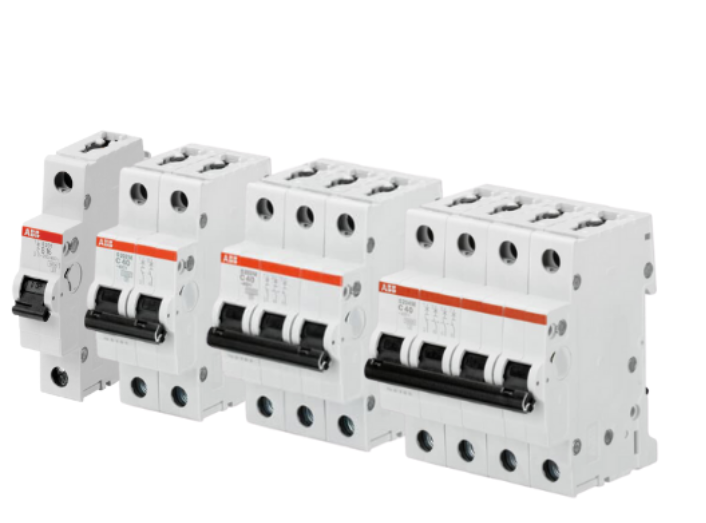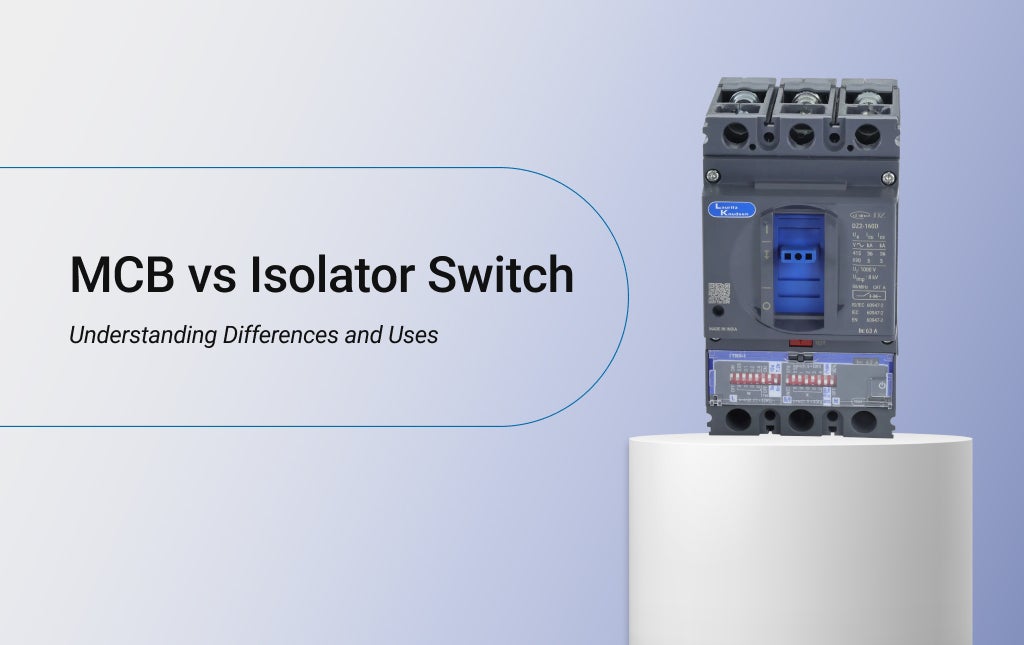MCB vs Isolator Switch: Understanding Differences and Uses

In electrical systems, safety and performance always occupy an important place. The life-saving components in the electrical circuit are the Miniature Circuit Breaker (MCB) and the isolator switch. They are the two industrial giants that play an essential role in the safety of electric circuits. Although both have the sole function of making safety equipment and protecting you from electrical hazards, they have different ways of doing it. This blog includes a detailed analysis of the MCB switch and the isolator Switch and highlights their functions, application area and importance in maintaining the central point of electricity installations. Awareness of these dissimilarities will allow users to understand the significance of choosing and placing this electrical equipment to achieve the required safe and accurate work in electrical systems.
If you want to invest in a reliable MCB or isolator switch, head straight to Lauritz Knudsen. With multiple choices in the same category of products, you will find multiple options to choose according to your needs.
Difference between isolator and mcb – Quick Navigation
Table of Content:
What is MCB?
A Miniature Circuit Breaker (MCB) is a safety device that protects electrical circuits from overcurrent and short circuits. Unlike traditional fuses, an MCB automatically disconnects the circuit when excessive current flows, preventing damage to electrical equipment. It has an arc-quenching system, which ensures safe breaking of the current without causing hazardous sparks. Understanding isolators and MCB difference is essential in picking the right device for electrical safety.

Uses of MCB
MCBs are widely used in electrical systems for their ability to give automatic safety against overcurrent and short circuits. Unlike traditional fuses, they do not need to be changed after tripping, making them a steady and cost-friendly choice. MCBs are key in both homes and work sites, keeping the power flow smooth and stopping risks. Below are some key uses of MCB in different setups.
1. Protection Against Overcurrent
MCBs are built to sense and cut off circuits with too much current flow. This helps stop wires from getting too hot, which can lead to fires or harm to devices. Knowing what is the difference between isolator and MCB helps in picking the right device for circuit safety.
2. Automatic Circuit Break
Unlike an isolator switch, an MCB works on its own when a fault happens. It trips at once without the need to be turned off by hand, keeping homes and work sites safe.
3. Better Electrical Safety
MCBs stop risky faults by shutting off power the moment a short circuit happens. They help protect both devices and wires, showing the need for an MCB and an isolator in keeping power use safe.
4. Good for Homes and Workplaces
MCBs are widely used in homes, offices, and other places to keep circuits safe. Their steady work and easy reset make them a better choice than old-style fuses.
5. Long Life and Strong Build
Unlike fuses that must be replaced, MCBs can be reset after tripping, making them a cheap and long-lasting fix for power safety. Knowing how to identify isolator and MCB helps in the right setup and use.
What is an Isolator?
An isolator is an electromechanical structure that disconnects the electric facility or its circuits from the main power distribution. It acts only when the system's current is zero. The isolator switch will offer you the maximum safety level during any electrical system maintenance. Nevertheless, the isolator switches usually do not have the lowest breaking capacity, as they have no arc suppression system.
The device performs the transitory passage of part of the electrical device from the alternating current, thus preventing flawed operation and, with this, starting damage to electronic device hardware. Technicians prefer isolators first because safety is essential.
Uses of Isolator Switch
An isolator switch plays a main role in power systems by letting users turn off circuits for fixing and checking. Unlike MCBs, isolators do not provide automatic protection but serve as manual disconnecting devices to ensure safety during servicing. They are often used in places with high power loads. Below are the main uses of isolator switches in power setups.
1. Safe Fixing of Electrical Circuits
An isolator switch makes sure that circuits are fully off during fixes. Unlike an MCB, which trips when there is a fault, an isolator switch must be turned off by hand to stop power flow. Knowing isolator and MCB difference helps in picking the right device for maintenance tasks.
2. Stops Risky Shocks
By cutting power to a circuit, this switch stops the risk of shocks while working. This is a key reason why an isolator switch vs MCB is used in different ways in power systems.
3. Used in High-Power Setups
Isolators are often used in places with high power needs where hand-controlled shut-off is a must. This helps in knowing what the difference is between an isolator and an MCB. Isolators do not offer automatic protection.
4. Adds a Layer of Safety
An isolator switch adds more safety, making sure no leftover charge is in a circuit performing maintenance. This shows how to identify isolator, and an MCB is key to using them right.
5. Key for Switching Tasks
While an MCB is made for safety, an isolator switch is mainly for cutting off power. Its role is to isolate a section of the circuit for safety, making it a must to know the MCB and isolator roles.
What is a Circuit Breaker?
Circuit breakers are the ultimate security device in the electrical system. They operate as a safety device and a protective device, shielding all electrical equipment from circuit overload and various faults. Circuit breakers respond immediately by identifying faults and interrupting or preventing circuit power flow. The severity or magnitude of the faulting is the factor that determines the period without power. The inner arc quenching system and the breakers enable them to take high circuit fault capacities for granted.
In addition, circuit breakers possessing the integrated extinguishing system have a higher withstanding capacity, making them tolerant of momentary trips and faults. As a result, they are typically used in heavy loads, such as transformers. They are focused on attribute engineering, such as biomaterials or biosensors, which target specific biological processes or interactions.
Difference Between Isolator and MCB
MCB and isolators differ in manifolds. Here are the key differences:
| Parameter | Isolator Switch | MCB (Miniature Circuit Breaker) |
|---|---|---|
| Purpose | Used for manually disconnecting electrical circuits for maintenance and safety. | Automatically disconnects circuits during overcurrent or short circuit situations. |
| Ratings | Withstand current 15–30 times higher than a circuit breaker; requires manual handling. | Designed for precise ratings to prevent overload and short circuits. |
| Operation | Operated manually; requires human intervention to switch ON/OFF. | Operates automatically; trips when current exceeds a preset limit using trip coils or bimetallic strips. |
| Function | Isolates the circuit for safe maintenance or repair under no-load condition. | Protects from overloads and short circuits, minimizing fire and equipment damage. |
| Contacts | Has stationary and movable contacts; no arcing protection; used under no-load. | Includes arc contacts; arc is drawn and extinguished during trips to protect system. |
| Earth Switch | Often used with an earth switch to discharge residual current safely. | Earth switch not typically used; MCBs detect and trip automatically on fault. |
| Cost | Relatively inexpensive due to simple construction. | More expensive due to complex components and autonomous protection features. |
| Installation | Installed at accessible points; must only be used after MCBs are turned off. | Installed in-line to interrupt current flow during faults or overloads. |
| Primary Use Case | Maintenance isolation and safety disconnect under no load. | Continuous circuit protection during load, overload, and short circuit conditions. |
| Complexity | Simple mechanical device. | More complex, involves sensing and tripping mechanisms. |
Also Read:
Conclusion
Contrary to isolator switches, circuit breakers are designed to protect electrical systems and maintain the reliability and safety of electrical equipment. The isolator switches function as manual disconnection tools; in contrast, circuit breakers equip us with an automatic protection feature against overcurrents and short circuits. Knowing what these components can do, operate, and install is essential, as well as determining which components are appropriate for use in a specific electrical operation.
Regarding all of your electrical requirements, like the range of splendid isolator switches, circuit breakers and other essential accessories, trust Lauritz Knudsen. The Smartshop offers a complete spectrum of advanced solutions that cover all electrical power units and devices. Thus, the customers can solve any electrical issue. Lauritz Knudsen is fully dedicated to meeting high standards of quality and dependability. The equipment will perform spectacularly and ensure the highest safety levels.
FAQs: Common Questions About isolator and mcb
Q1. Which device is better for protecting electrical circuits—MCB or Isolator Switch?
Ans: An MCB is better for keeping circuits safe as it cuts power on its own when faults happen. An isolator switch vs MCB check shows that an isolator only shuts off power by hand, while an MCB works at once when needed.
Q2. What are the safety advantages of using an MCB over an Isolator Switch?
Ans: MCBs trip right away when there is too much current or a short, stopping damage and fire risks. Unlike an isolator switch, which must be turned off by hand, an MCB keeps users safe without any help, showing what is the difference between an isolator and an MCB in safety work.
Q3. Can an MCB be used to isolate a circuit?
Ans: No, an MCB is built for safety from faults, not for cutting off power. A good isolator switch vs MCB look shows that isolators are for cutting off power, while MCBs stop overloads and shorts.
Q4. How do you properly maintain an MCB or Isolator Switch?
Ans: To maintain an MCB, regularly inspect for overheating and test its trip function. For an isolator switch, ensure it fully disconnects the circuit and check for loose connections. Learning how to identify an isolator and MCB helps in good maintenance.
Q5. Are MCBs suitable for residential applications?
Ans: Yes, MCBs are widely used in homes to stop overloads and short circuits. This shows the role of the MCB and isolator in keeping home power use safe.
Q6. How do Isolator Switches help in electrical safety?
Ans: An isolator switch makes sure a circuit is fully off before maintenance starts, stopping shocks. This point is key in knowing the isolator and MCB difference and their safety roles.

